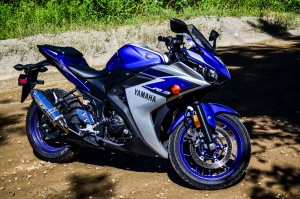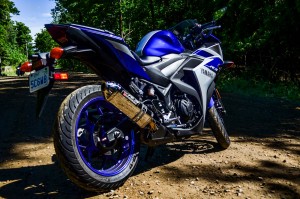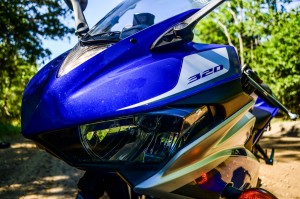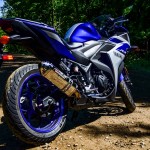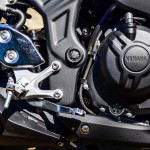Yamaha timed the launch of its R3 perfectly to join the slew of entry-level bikes being introduced and upgraded. Prior to its launch, Yamaha’s sportbike line-up consisted only of the R6 and R1. Both of these rides are incredibly popular, and with good merit. The R3 serves as an ambitious young wolf added to a pack of veteran prowlers. And boy does this wolf bite. A 321cc four-stroke inline twin hides underneath the fairings of the sporty R3, beating the Kawasaki Ninja 300 by 25cc, and the CBR300R by 35cc. The RC390 comes in with the most power, yet at the cost of, well, costing more.
Keeping the displacement on the lower end of the 300 range was a strong decision by Yamaha, still keeping it price competitive with Honda and Kawasaki, while surpassing them in power. Those extra few cubic centimetres really make a whopping difference. Though unsurprisingly lacking in low-end torque (though it pulls much stronger than the Ninja), the R3 will happily take off in the upper-mid to high-rev ranges. Passing power at highway speeds, which is often a concern directed towards entry-level bikes, is more than ample. Dropping down to fifth from sixth will unlock more than enough torque to pull in front of that slow-moving Corolla. That being said, sixth offers enough power as well; gear ratios are well designed such that cruising at highway speeds in both fifth or sixth are reasonable. The transmission itself is butter smooth, and virtually flawless. Fuel-injection is also well-mapped when the bike is warm, but I noticed a bit of initial throttle lag when starting the bike after a mere 5 hours of sitting in my garage.
One of the more outstanding features, as compared to the CBR300R and Ninja 300, is the adjustable shift-light, which lights up at an adjustable rpm indicating that it is a good time to shift up. For new riders, this will aid in the building of a sense of familiarity with the sound of the bike and how it relates to gear shifting. The rest of the dash is not all that unique. It features an analog tachometer, a digital fuel gage, trip meters, and fuel trip indicator as well. The edges around the instruments and cluster add to the bike’s overall edgy look, feel, and appeal.
The R3 definitely makes a mark as my favourite starter bike in terms of aesthetics. This bike truly looks fast. The full fairings and graphics give it a sporty look, and the front-end aggression gives it that Yamaha racing edge. The only thing that doesn’t quite sit well with me is the poorly placed arrow-shaped headlight underneath the windscreen. Why, Yamaha, why?
I noticed it first on the R1; Yamaha does a phenomenal job of making bikes feel stable at high speeds in a straight line. On the R1, I could tuck-in behind the windscreen and it would feel as if I’m safe in a little cockpit, and the bike doesn’t feel like it’s making much of an effort to go fast. On the GSX-R1000, you could feel the speed, which isn’t necessarily a negative thing. The R3 falls in line with its big brother (or should I say father, the R6 is a likely brother) in that I felt as calm as a fly on the right side of the window when tucked away behind its windscreen.
Though the riding position is more upright than the R6 and R1, the tuck feels comfortable and the cockpit is roomy. Part of that roomy-feeling cockpit comes from how narrow this bike is. The R3 feels very small and slim in the saddle, which, combined with the low 30.7 inch seat height, makes the bike accessible for our shorter riding friends. The 14L tank drinks responsibly, but feels as if it physically bulges up quite high. Taking the curvy back roads on the R3 is fun, but it also drilled in the fact that the R3 is, all things considered, still a starter bike.
The 41mm KYB fork in the front is not adjustable, and the linkless rear suspension can only be adjusted in terms of preload. The suspension and chassis are a little bit too soft for my liking, and road feedback was not quite adequate. That being said, it took the corners well if all inputs to the bike were smooth and progressive. Diving into turns was easy, as the bike is light even for a low-displacement vehicle, weighing in at 366 lbs dry. This bike can really be flicked around, but it is not how it should be ridden. Aggressive riding on the R3 will be met with demise, while smooth riding will be rewarded. The only true fault, it seems, are the brakes: they are simply too weak. Oftentimes, when riding a little more aggressively, I found myself squeezing front brake lever all the way to the grips to come to a quick stop. The lack of initial bite is new rider friendly, but stopping power could still be improved.
The R3 remains price competitive with the CBR300R and Ninja 300 at $4999. There are also a slew of accessories available, including this Yoshimura pipe for an additional $500. For reasons unknown, Yamaha is unfortunately not including ABS as a feature on their R3s in North America at this point in time.

